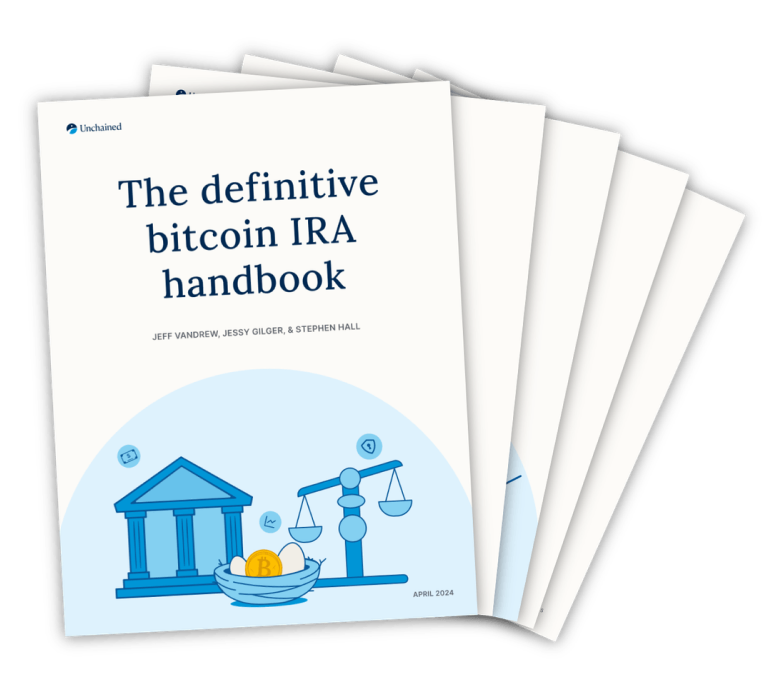
The definitive bitcoin IRA handbook


If your income is higher than a certain amount per year as designated by the IRS, there are special provisions you must consider as it relates not just to bitcoin IRAs, but IRAs in general. Here we’ll consider backdoor contributions, which allow you to contribute to a bitcoin Roth IRA even if your income exceeds the IRS income ceiling.
While there are no income limitations on converting a Traditional IRA to a Roth IRA, and no income limitations on any rollovers to a bitcoin Roth IRA like the Unchained IRA, there are income limitations on making annual contributions from personal funds to a Roth IRA.
Many bitcoin buyers who are over this IRS income limit would still like to make annual contributions each year. This is where the backdoor contribution process comes in.
To make a backdoor Roth contribution each year, you’ll first need to open a Traditional IRA at a discount broker. Many offer this service for free, including Ameritrade, Schwab, eTrade, and more (all are fine for this purpose). You’ll only need to open it once, and you can use it every year for the backdoor.
This backdoor contribution process will work every year so long as you have no unconverted Traditional (non-Roth) IRA balances (although any 401(k) or other employer plan balances are fine).
Each year, you need to make a contribution equal to the current IRA annual contribution limit to that brokerage Traditional IRA. Because you are over the income limit for a Traditional IRA, you will get no tax deduction for that contribution. For the purposes of the backdoor contribution process, this is a good thing, as we will explain below.
You will then ask the brokerage to do a Roth conversion. The brokerage will move the funds from the Traditional IRA into a new Roth IRA at the brokerage, while keeping the Traditional IRA open with a zero balance.
After the Roth conversion at the brokerage, you then need to perform a Roth-to-Roth transfer to your bitcoin IRA. For your Unchained IRA, you’ll fill out an Unchained IRA transfer form and submit it to us. This will initiate a Roth-to-Roth transfer from your discount broker to your Unchained Roth IRA.
From the point of view of your Unchained IRA, this is just a Roth transfer, not a backdoor. This is because the “backdoor” portion of the contribution was completed at the discount brokerage.
When doing the transfer from the brokerage to your Unchained Roth IRA, you will want to transfer slightly less than the full amount, leaving $5 (or even $0.50) in the brokerage Roth, so that the brokerage won’t close your Traditional and Roth accounts and you can use them for future backdoor contributions. That also usually avoids the brokerage account closure fee.
If you do a backdoor contribution, at the beginning of the following year, you’ll get a 1099R from the discount broker you used showing the Roth conversion (separate from the nontaxable 1099R showing the transfer to your bitcoin IRA). So long as you explain to your tax preparer that this Roth conversion was part of a backdoor contribution (i.e, that you made a nondeductible Traditional IRA contribution preceding it), they should properly report the Roth conversion as nontaxable on Form 8606 with your personal tax return.
The $6,000 non-deductible contribution that you make annually to a Traditional IRA is reported on Form 8606, Part I, and the Roth conversion gets reported on Form 8606, Part II. You’ll see that on Form 8606, Part II, the amount from Part I gets subtracted to determine the taxable amount. So each year you should have a nondeductible contribution of $6,000 and a conversion of $6,000, which should net out to zero taxable income.
Whether you’re above the income limit and need to perform a backdoor contribution, or just get started contributing to your bitcoin Roth IRA directly, Unchained is here to help. Our Unchained IRA lets you save bitcoin on a tax-advantaged basis while holding your own keys with multisig, and you can learn more in our webinar below.
This article is provided for educational purposes only, and cannot be relied upon as tax or legal advice. Unchained makes no representations regarding the tax consequences of any transaction described herein, and all such questions should be directed to an attorney or CPA of your choice.